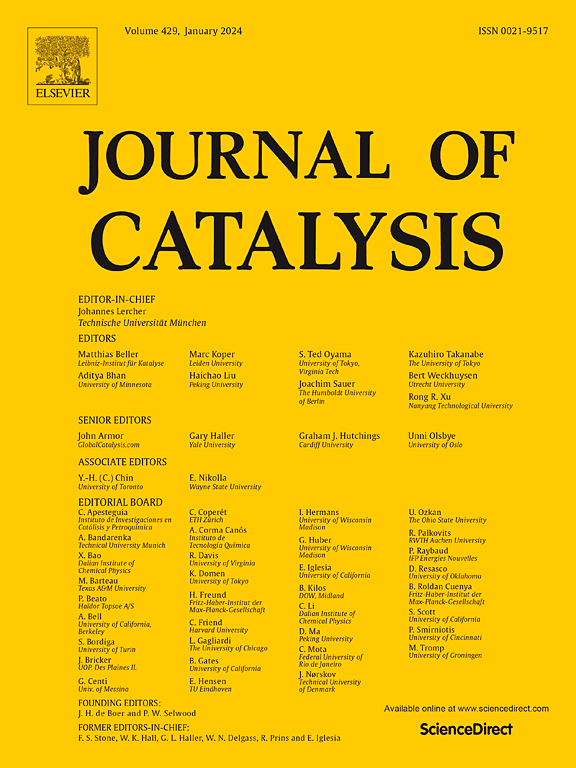高性能pemfc增强压缩应变PtCo金属间催化剂的气相分散工程
IF 6.5
1区 化学
Q2 CHEMISTRY, PHYSICAL
引用次数: 0
摘要
pt基合金在质子交换膜燃料电池(pemfc)中表现出优异的氧还原反应(ORR)催化活性,但过渡金属浸出引起的不稳定性给其带来了严峻的挑战。与无序合金相比,结构有序的PtM金属间化合物(IMCs)表现出更高的稳定性,但其传统的高温合成方法往往会导致颗粒聚集和催化性能降低。在此,我们提出了一种无溶剂气相分散策略,利用乙酰丙酮酸前体的挥发性来合成具有超小尺寸(3.0 nm)和均匀压缩晶格应变的有序PtCo IMC纳米颗粒(PtCo/C-IMC)。PtCo/C-IMC催化剂具有优异的ORR活性(0.92 A mgPt−1在0.9 V)和耐久性(6.8 %活性衰减后,100,000循环)。在H2-air质子交换膜燃料电池,它达到峰值功率密度为1.53 W 厘米−2 0.6 V和展示了出色的操作稳定性、电压损失的只有17 mV(0.8 厘米−2)和21 mV(1.5 厘米−2)30000年以后加速寿命试验(ADT)周期,超过了美国能源部2025年目标和优于大多数报道的催化剂。密度泛函理论(DFT)计算和后adt表征表明,工程压缩应变增强了Pt-Co原子相互作用,优化了电子结构,提高了Co的空位形成能。这些效应增强了催化活性和稳定性,为设计先进的PEMFC催化剂提供了可扩展的途径。本文章由计算机程序翻译,如有差异,请以英文原文为准。


Gas-phase dispersion engineering of PtCo intermetallic catalysts with enhanced compressive strain for high-performance PEMFCs
Pt-based alloys demonstrate superior catalytic activity for the oxygen reduction reaction (ORR) in proton exchange membrane fuel cells (PEMFCs), yet their instability due to transition metal leaching poses a critical challenge. While structurally ordered PtM intermetallic compounds (IMCs) exhibit enhanced stability compared to disordered alloys, their conventional high-temperature synthesis often induces particle aggregation and diminished catalytic performance. Herein, we present a solvent-free gas-phase dispersion strategy leveraging the volatility of acetylacetonate precursors to synthesize ordered PtCo IMC nanoparticles (PtCo/C-IMC) with ultrasmall size (3.0 nm) and uniform compressive lattice strain. The PtCo/C-IMC catalyst delivers exceptional ORR activity (0.92 A mgPt−1 at 0.9 V) and durability (6.8 % mass activity decay after 100,000 cycles). In H2-air PEMFCs, it achieves a peak power density of 1.53 W cm−2 at 0.6 V and demonstrates outstanding operational stability, with voltage losses of only 17 mV (0.8 A cm−2) and 21 mV (1.5 A cm−2) after 30,000 accelerated durability test (ADT) cycles, surpassing the DOE 2025 targets and outperforming most reported catalysts. Density functional theory (DFT) calculations and post-ADT characterization reveal that the engineered compressive strain strengthens Pt-Co atomic interactions, optimizes the electronic structure, and elevates the vacancy formation energy of Co. These effects enhance both catalytic activity and stability, offering a scalable pathway for the design of advanced PEMFC catalysts.
求助全文
通过发布文献求助,成功后即可免费获取论文全文。
去求助
来源期刊

Journal of Catalysis
工程技术-工程:化工
CiteScore
12.30
自引率
5.50%
发文量
447
审稿时长
31 days
期刊介绍:
The Journal of Catalysis publishes scholarly articles on both heterogeneous and homogeneous catalysis, covering a wide range of chemical transformations. These include various types of catalysis, such as those mediated by photons, plasmons, and electrons. The focus of the studies is to understand the relationship between catalytic function and the underlying chemical properties of surfaces and metal complexes.
The articles in the journal offer innovative concepts and explore the synthesis and kinetics of inorganic solids and homogeneous complexes. Furthermore, they discuss spectroscopic techniques for characterizing catalysts, investigate the interaction of probes and reacting species with catalysts, and employ theoretical methods.
The research presented in the journal should have direct relevance to the field of catalytic processes, addressing either fundamental aspects or applications of catalysis.
 求助内容:
求助内容: 应助结果提醒方式:
应助结果提醒方式:


